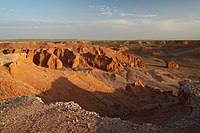
Photo from wikipedia
ABSTRACT We report on the discovery of new skulls and dentitions documenting a broader geographic and stratigraphic range for the eutherian mammal Asioryctes nemegtensis. Originally discovered in the Upper Cretaceous… Click to show full abstract
ABSTRACT We report on the discovery of new skulls and dentitions documenting a broader geographic and stratigraphic range for the eutherian mammal Asioryctes nemegtensis. Originally discovered in the Upper Cretaceous Barun Goyot Formation of the Gobi Desert, Mongolia, A. nemegtensis has been hypothesized to be absent from the Djadokhta Formation, another Upper Cretaceous Gobi Desert formation. This distinction has previously contributed to an emphasis on faunal and age dissimilarity between the two sets of Cretaceous rocks. Here we report four new specimens of A. nemegtensis from the Djadokhta Formation and document its first co-occurrence with its sister taxon, Ukhaatherium nessovi. The new specimens reveal additional details about the cranial and dental anatomy of asioryctitheres and prompt an alpha taxonomic revision and emended diagnosis for A. nemegtensis. Among the new specimens are a nearly complete skull and several articulated jaws, which provide new information on tooth occlusion. These discoveries are an additional datapoint indicating that some Upper Cretaceous faunal assemblages in Mongolia are not as distinctly different in composition and age as has been previously hypothesized.
Journal Title: Journal of Vertebrate Paleontology
Year Published: 2022
Link to full text (if available)
Share on Social Media: Sign Up to like & get
recommendations!